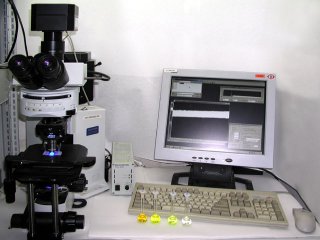|
Long exposure performed by CCD camera is often damaged by thermal
noise. CMOS detectors generate even higher noise than CCD ones.
Conventional still cameras usually do not provide any means to control
the detector temperature. Heat generated by camera electronics makes
noise even worse after some period of camera operation.
This is why scientific-grade CCD cameras perform 16-bit pixel
digitization and use full-frame CCD detectors with high QE and bigger
pixel potential-well capacity, which ensures high dynamic range. Such
cameras also employs CCD detector cooling. CCD thermal noise typically
doubles every 6 or 7 °C. Thus cooling a
CCD detector 42 °C below ambient
temperature lowers CCD thermal noise at last 64×.

G2 CCD camera attached to Olympus microscope The cooled G2-0402 CCD camera attached to the Olympus microscope is
used at Institute of Chemical Technology Prague for instance to study
induced bioluminescence of certain microorganisms.
| 